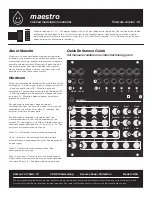
St
re
am
in
g E
xp
eri
m
en
ts
21
The
Numeric
view shows your columns of data arranged in a table. Although only
four columns are displayed, there are actually ten columns available. Use
Y
and
Z
to move from column to column; use
X
and
W
to navigate through the data
in a column.
One key to understanding the Statistics Aplet is the
!1VARqqq!
/
!2VARqqq!
menu key. Press
this key to toggle between 1-variable and 2-variable statistics. If set to
!1VARqqq!
, you
are studying the data column by column; if set to
!2VARqqq!
, you are studying the
relationship between any two columns of data. Press
Q
to enter the
Symbolic
view
of the Aplet and define which columns to study. In
1-VAR
mode, the
Symbolic
view
will let you define up to five histograms, or box-and-whisker plots: H1, H2, H3, H4,
and H5. Each plot can take one column for its data and another for its frequency,
or one column for the data and a common frequency you enter manually. In
2-VAR
mode, the
Symbolic
view will let you define up to five scatter plots (S1, S2, etc.).
Press
@
Q
(Plot Setup) to select a fit model for each scatter plot.
The easiest way to see a graph of your data is to press
V
and select the
Autoscale
option. If your graph is a scatter plot, press
@MENU!
and then
$@FIT#@
to
see the fit model plotted with your data. The views of the Statistics Aplet are
summarized in Table 2-8 and Table 2-9. For more information, please refer to the
HP 39/40gs
User Guide
.
Table 2-8 Views in the Statistics Aplet
Symbolic
Plot
Numeric
Figure 2-14 Define an
analysis
Figure 2-15 Statistical
plot
Figure 2-16 Table of
values
















































